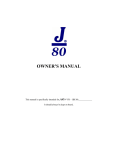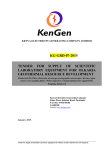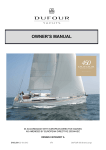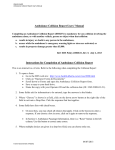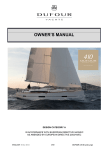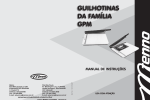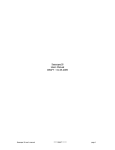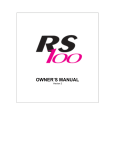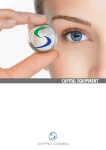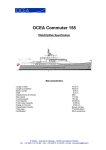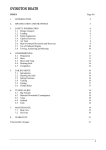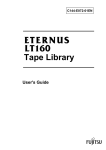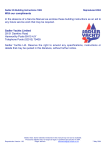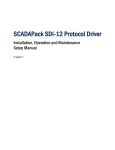Download This manual is specifically intended for J 80 N° FR – JBE
Transcript
This manual is specifically intended for J 80 N° FR – JBE 80_____________ It should always be kept on board. J 80 N° FR – JBE 80_____________ Copy right J/Boats,Inc.,2009 J/80-Page 1/35 INTRODUCTION Welcome aboard and to the family of " J " owners. J/ Boats Asia is pleased to give you this manual that will help you to get to know your boat better. “J” J/ Boats This manual is designed to help you get the maximum pleasure from your boat in total safety. It contains details of the boat, the equipment supplied and fitted, the installations and instructions on its use and maintenance. Read it through carefully and familiarize yourself with your boat before you set sail. If this is your first boat or if you are changing to an unfamiliar type of boat, please ensure for your comfort and safety, that you have experience of handling and using it before taking over command. Your dealer, your national sailing association or your local sailing club will be very pleased to advise you on sailing schools and skilled instructors in your area. PLEASE KEEP THIS MANUAL IN A SAFE PLACE AND PASS IT ON TO THE NEW OWNER IF YOU SHOULD SELL THE YACHT. Copy right J/Boats,Inc.,2009 J/80-Page 2/35 CONTENTS 1. TECHNICAL CHARACTERISTICS 2. YACHT DESIGN CATEGORY 3.CONSTRUCTI ....................................................... ............................................................. .................................................................. ................................ 3.1. THE COMPOSITE LAMINATE 3.2. KEEL - RUDDER ...................................................... ................................................................................... 4. INTERIOR LAYOUT ................................................................................ 4.1. COMPANIONWAY .............................................................................. ......... 4.2. SALOON …………………………………………………………………… 4.3. FOREPEAK 4.4. AFT PEAK .................................................................................... .......... ................................................................................. .......... ....... 5. ELECTRICITY 5.1. GENERAL .................................................................................................. ...................................................................................................... 5.2. 12 V SYSTEM 12V .................................................. …....... …...................... 5.3. ELECTRICAL CONSUMPTION 5.3.1. Calculating consumption ............................................................ ....................................................................... 5.3.2. Maximum electrical equipment consumption 5.3.3. Examples of electrical equipment consumption 5.3.4. Installing new equipment 6.2. SAFETY .................... .................................................................. 6. MECHANICAL SYSTEM 6.1. GENERAL ....................... . ....................................................................... ....................................................................................................... .......................................................................................................... 7. FLOODING / BAILING. 8. FIRE PROTECTION / ......................................................................................... 8.1. CHARACTERISTICS 8.2. SAFETY INSTRUCTIONS 9. SAILS AND RIGGING Copy right J/Boats,Inc.,2009 .......................................................................... ................................................................................... .................................................................... ............................................................................. J/80-Page 3/35 9.1. RIGGING ...................................................................................................... 9.2. GENOA FURLING SYSTEM 9.3. SAILS .................................................. ................................................................................................................ 9.3.1. Breaking in ................................................................................................. 9.3.2. Tensioning ............................................................................................ 9.3.3. Furling and maintenance .................................................................. 9.3.4. The spinnaker (option) 9.3.5. Setting the sails .............................................................. .......................................................................................... 9.4. RUNNING RIGGING 10. DECK FITTINGS 10.1. MAINTENANCE ........................................................................... ..................................................................................... ........................................................................................... 10.2. INSTALLING ADDITIONAL DECK FITTINGS 11. MAINTENANCE OF THE UNDERBODY 11.1.PROTECTION 11.1.1. The hull . .............. ........................................... ................................................................................................ ....................................................................................................... 11.1.2. The ballast 11.2. SCRUBBING .............................................................................................. .............................................................................................. 12. MAINTENANCE OF TOPSIDES ............................................ 12.1. Maintaining the TOPSIDES and the deck 12.2. Repairs to the hull or the deck 12.2.1. Light scratches ................. .................................................... ................................................................................... 12.2.2. Cracks in the gelcoat in smooth areas 12.2.3. Cracks in the anti-skid surface :............................... ....................................................... 12.2.4. Cracks affecting the laminate ................................................. 12.3. Scratches TO the port-LIGHTS ............................................................ 13. LIGHTNING PROTECTION 13.1. Protecting people during a storm 13.2. Following a lightning strike Copy right J/Boats,Inc.,2009 ................................................................. ............................................... .................................................... J/80-Page 4/35 14. PROTECTING THE ENVIRONMENT & SAFETY 15. SAFETY EQUIPMENT 16. LIFTING, HAULING OUT 17. WARRANTY & .................... ............................................................................ ................................................................... .................................................................................................... Copy right J/Boats,Inc.,2009 J/80-Page 5/35 TABLE OF APPENDICES DECK PLAN ....................................................................................................... A2 SAIL PLAN .......................................................................................................... A3 RUNNING RIGGING .......................................................................................... A4 ELECTRICAL DIAGRAM ...................................................................................... A5 ............................................................................................................. A2 ....................................................................................................... A3 ............................................................................... ...... .................... ....... A4 ...................................................... ............... ………............... ....... ............ A5 Copy right J/Boats,Inc.,2009 J/80-Page 6/35 Local J Boats Asia dealer J Boats Asia NAME: _________________________________________________ ADDRESS: _________________________________________________ _________________________________________________ _________________________________________________ TEL: _________________________________________________ FAX: ______________________________________________ This is our local representative who can provide all the necessary assistance and answer all your questions. He can also guide and advise you on the technical checks for commissioning your boat and on how to maintain it. As soon as you receive your owner’s manual date and sign the receipt below and return it within 8 days to J Boats Asia, to be covered by our warranty. The warranty is not valid unless the receipt is returned to the manufacturer on time. If not, the delivery date will be taken into account as departure for the warranty (Conditions of the warranty ). 8 J Boats Asia Copy right J/Boats,Inc.,2009 J/80-Page 7/35 CERTIFICATE OF WARRANTY I, undersigned, Name ………………………………………………… Address ……………………………………………… ……………………………………………… ……………………………………………… Country ……………………………………………… Owner of J 80 N° FR-JBE80………………………. declare that I have received the owner’s manual, including the declaration of conformity with the registered tonnage of a standard production yacht and the declaration of CE approval. The vessel has been delivered complete and in good condition. This vessel is covered by the warranty conditions detailed on page 21 of the owner’s manual. This warranty commences from …………………………, the date of delivery of my vessel. Date ……………………. Signature: …………………. ……………………………………………… ……………………………………………… ………………………………………………. J 80 N° FR-JBE80 CE 21 ………… …………………… Copy right J/Boats,Inc.,2009 …………………… J/80-Page 8/35 1. TECHNICAL CHARACTERISTICS Design category B : N° A JCF 980112 V Certificate Length of hull 8.00 m : Length waterline 6.70 m : Maximum beam 2.50 m : Draught (light) 1.50 m : 11.4 m Air draught Weight of ballast 675 kg : Displacement (light) : 1450 kg Maximum permitted load : 950 kg Tonnage (for customs purposes) 3.83 Tx : Number of persons allowed according to A B C D category 0 Mainsail area 21.0 m² Medium genoa area 20.2 m² Solent jib area 14.0 m² Storm jib area 3.0 m² I: 9.60 m J: 2.90 m P: 9.14 m E: 3.81 m Outboard engine : 5 8 8 3.5P Maximum permitted power 4,5 kW Service battery 12 V 1 x 55 A : Copy right J/Boats,Inc.,2009 J/80-Page 9/35 Wetted surface area 10 m² Mast RDM Sparcraft extrusion IMS 80 Boom RDM Sparcraft extrusion F 60 Furling system Harken unit 00 : 2. YACHT DESIGN CATEGORY Your J 80 is classed under the "OFFSHORE" design category (Category B) of the European directive for yacht construction (Ref. 95/25/CE). J80 “ ” B ( 95/25/CE) Its ability to sail also depends on the skills of the crew, their physical capabilities, the condition of the boat and its equipment. Please therefore take these into account before you set out to sea. J Boats Asia cannot guarantee that the vessel will function perfectly in exceptional conditions (violent storms, hurricanes, cyclones, waterspouts, etc.). J Boats Asia ( ) At J Boats Asia, our craftsmen have devoted all their skills and energy to building you a boat you can be proud of and which will provide you and your crew with the greatest enjoyment. J Boats Asia Copy right J/Boats,Inc.,2009 J/80-Page 10/35 3. CONSTRUCTION Your J 80 has not only received the greatest care and attention from everyone involved in its construction but also benefits from architectural and technological innovations that make this boat state of the art. J Boats Asia has drawn on its long experience to select only products of the highest quality for your J 80. J 80 J Boats Asia J80 3.1. THE COMPOSITE LAMINATE The hull is made from a balsa-GRP sandwich laminate with uniaxial and bidirectional cloths. It is molded in one piece. The glass cloth is entirely laid up by hand. The resin and the quality of the gelcoat used guarantees the hull against osmosis for 5 years. The deck is made from a glass fibre-balsa sandwich laminate. It is very resistant to compression. The cloths and moulding techniques used are the same as for the hull. The bottom is reinforced with a series of floor frames laminated to the hull, then covered with a partial moulding. 3.2. KEEL - RUDDER The keel with bulb is in lead protected by an epoxy treatment. Its is solidly bolted to the hull, with the help of a stainless steel backing plate and nuts. Copy right J/Boats,Inc.,2009 J/80-Page 11/35 This is installed towards the end of construction, as soon as the hull has been strengthened enough to avoid any risk of deformation. The suspended rudder blade is made from GRP. 4. INTERIOR LAYOUT Moulded interior sole made from FRP with diamond nonskid effect. Forward (under berths) and aft spaces provide reserve buoyancy. 4.1. COMPANIONWAY Easy access from the cockpit Companionway fitted with removable step GRP sliding hatch Plexiglas washboard with lock and ventilation 4.2. SALOON Very spacious, lit by 2 coachroof port-lights and the large companionway hatch. 2 Settee berths facing each other (with mattress on option), stowage underneath. Spotlight on bulkhead Copy right J/Boats,Inc.,2009 J/80-Page 12/35 4.3. FOREPEAK Double berth with stowage underneath Lighting and ventilation by 420x420 hatch 1 420x420 4.4. AFT PEAK Vast stowage area either side of the companionway. Stowage space under berth. Copy right J/Boats,Inc.,2009 J/80-Page 13/35 5. ELECTRICITY Your J 80 is equipped with a 12 V DC and a 230 V AC system J80 12V 230V 5.1. GENERAL IMPORTANT Always : .. Check the condition of the batteries and the charging system before putting to sea. .. Disconnect and remove the batteries for winter storage. .. Keep the battery voltage at more than 10.5V during winter storage. .. Check that the navigation equipment is working. .. Check that the navigation lights are working before sailing at night and carry replacement bulbs for all the navigation and internal lights. Never : .. Work on any electrical equipment while it is connected. .. Modify the electrical installation or the main wiring unless this is done by a qualified marine electrician. .. Change or modify the breaking capacity of any overload protection. . Install or replace any electrical equipment with components rated for a higher capacity than that prescribed without recalibrating the conductors and the fuses. .. Leave the boat unattended when the electrical equipment is on. 10.5V 5.2. 12 V SYSTEM 12V The 12V system comprises of one 55Ah battery and a 3 function electrical Copy right J/Boats,Inc.,2009 J/80-Page 14/35 switchboard. The battery is located under the forward berth at the mast step. Each battery pole is linked to a circuit breaker. 12V 55 Ah The 12V DC switchboard, located over the port fore berth, is equipped with fuses. The relevant diagrams are found in the appendices. 12V To switch the system on, close the " + " and " - " circuit breakers. This feeds power to the electrical switchboard. Each function is protected by a fuse whose ratings are given in the appendices. "+" "-" Press the appropriate switch to activate a function. 5.3. ELECTRICAL CONSUMPTION The capacity of the batteries has been designed to provide the power requirement of all onboard accessories. To avoid problems, however, always ensure that the batteries are properly charged and maintained. IMPORTANT If you install any new electrical equipment, please ensure that the battery capacity is still suitable for the new overall level of consumption. 5.3.1. Calculating consumption Copy right J/Boats,Inc.,2009 J/80-Page 15/35 To calculate the consumption of your equipment and determine how much life your batteries have before they require recharging, multiply the consumption by the number of items of equipment and the operating time in hours. e.g. : 1 navigation light 2 Ah x 1 light x 3 hours = 6A The battery output is 70% so the result must be multiplied by 1.4, i.e. : 6 x 1.4 = 8.4A. 1 2 Ah x 1 x3 70% 6A 1.4 6 x 1.4 = 8.4A. 5.3.2. Maximum electrical equipment consumption Type of equipment Consumption Two-colour light 1.8A Interior light 0.8A Electric pump 3.5A 5.3.3. Examples of electrical equipment consumption Type of equipment Consumption VHF radio telephone in standby mode 1A VHF radio telephone transmitting 5A Log speedo 0.1A Anemometer 0.1A Automatic pilot 1 to 3A 5.3.4. Installing new equipment Since 1st January 1996, all electrical equipment is subject to the European "Electromagnetic Compatibility' 'directive (Ref 89/336/CEE). Any new equipment installed must conform to this standard and be CE marked. The equipment must also be supplied with a certificate of conformity and a user’s manual. Copy right J/Boats,Inc.,2009 J/80-Page 16/35 1996 1 1 89/336/CEE CE Please contact your dealer about installing such equipment or carefully follow the installation instructions (particularly the sections on wiring and system protection). 6. MECHANICAL SYSTEM 6.1GENERAL Your J 80 is fitted with an outboard bracket on the transom for the fitting of an outboard long shaft engine of 15kW maximum power. 15kW J80 6.2. SAFETY BE CAREFUL ! Match the speed of your boat to the surrounding conditions in all situations, leaving a margin of safety. Pay particular attention to : The sea conditions, currents and the force of the wind. Traffic. Manoeuvring in port. Passing through moorings. The stowage of the fuel tank. 7. FLOODING / BAILING / The J 80 has a bilge pump allowing the boat to be bailed. This manual bilge pump, located in the cockpit, draws water from the sump under the saloon sole. J80 Copy right J/Boats,Inc.,2009 J/80-Page 17/35 Read the instructions for the pumps carefully, especially the maintenance instructions. ATTENTION To reduce the risk of water flooding the boat : .. Close the deck hatches and the port-lights before sailing. . Close the plumbing sea-cocks when sailing. . Periodically check: - the seals on the sea-cocks, valves and plumbing. - that the cockpit drains are flowing freely. -the seals on the rudder bearing. 8. FIRE PROTECTION . 8.1. CHARACTERISTICS Your J 80 should be equipped with at least 1 fire extinguisher located near the companionway. The capacity should be minimum 5A/34B. The emergency exit is the companionway. J80 Copy right J/Boats,Inc.,2009 5A/34B J/80-Page 18/35 8.2. SAFETY INSTRUCTIONS IMPORTANT It is the boat owner’ s or captain’ s responsibility to : .. Check the fire extinguishing equipment in accordance with the manufacturer’ s instructions. .. Replace any out of date or used fire extinguishing equipment with equipment of similar or of higher capacity. .. Ensure that the fire extinguishing equipment is readily accessible when the boat is occupied .. Instruct every member of the crew regarding: the location and operation of the fire extinguishing equipment the location of the emergency exits ATTENTION Always : .. Keep the bilges clean and regularly check for the build up of fuel vapour or gas .. Only replace items of fire extinguishing equipment with similar equipment of the same description, technical capacity and fire resistance Never : .. Obstruct access to the emergency exit. .. Obstruct access to safety controls. .. Obstruct lockers housing fire extinguishers. .. Leave the boat unoccupied with a gas appliance on. .. Use gas lamps in the boat. .. Refill the fuel tank when the engine is running. .. Smoke when handling fuel or gas. Copy right J/Boats,Inc.,2009 J/80-Page 19/35 ATTENTION .. CO2 extinguishers should only be used for electrical fires. 9. SAILS AND RIGGING 9.1. RIGGING The mast is an essential part of your yacht: it is well dimensioned and well provided with stays. You must, however, tension it correctly and regularly check the condition of the mast and standing rigging. Carefully read the mast manufacturer’s instructions. 9.2. GENOA FURLING SYSTEM Your J 80 is fitted with a Harken unit 00 furling system specially selected for its ease Copy right J/Boats,Inc.,2009 J/80-Page 20/35 of use, robustness and the quality of service provided by the manufacturer. Regularly check the condition of the drum and the tubes. Follow the manufacturer' s instructions. J80 Harken unit00 9.3. SAILS The sails are your yacht’s main source of propulsion. Take good care of them and they will provide maximum power. They are very susceptible to friction wear. The synthetic fibres can be damaged by chafing, particularly on the seams. Mark any places where there is a risk of chafing and protect them. Do not let your sails flap because this can break the fibres inside the sails. 9.3.1. Breaking in It is very important to break in your sails. In fact, they will take their proper shape and the threads in the seams will stretch to their final position under their initial load. Your sails will only keep their good appearance and provide good service if they are properly broken in. 9.3.2. Tensioning You must apply equal tension to the sail in all directions (luff, leech and foot) For a headsail, the more you harden the sheet, the more you have to tighten the luff. Copy right J/Boats,Inc.,2009 J/80-Page 21/35 For a mainsail, the more tension on the leech, the more you have to tighten the foot and the halyard. 9.3.3. Furling and maintenance You should always take time to furl your sails carefully. How they are folded is very important, even at sea. If the sails are wet with seawater, rinse them thoroughly with freshwater and allow them to dry before folding them. They should be flaked along the seam and then rolled from the clew. If the sails are to be permanently rigged, we recommend that you protect them from UV rays and the weather (the furling genoa with a protective UV strip or a cover, the mainsail with a cover). Never use acetone or soda to clean the sails. 9.3.4. The spinnaker (option) The J80 is designed to fly an asymmetrical spinnaker. It must be carefully packed before use to avoid tangling. Remember to fully extend your bowsprit before hoisting the spinnaker Leave the genoa in place when setting the spinnaker, then furl it once the spinnaker is set. In the same way, unfurl the genoa before handing the spinnaker. Copy right J/Boats,Inc.,2009 J/80-Page 22/35 J80 9.3.5. Setting the sails The following table provides an idea of which sails to set according to the wind conditions but factors other than the wind must also be borne in mind: The sea state. The comfort and capacity of the crew. Entering and leaving port, proximity to danger. Expectation of heavy weather or fog. WIND SAILS BEATING REACHING Beaufort BROAD RUNNING REACHING Scale Main Full Full Full Full 0 to 2 Genoa Full Full or spi Full or spi Full or spi 2 to 3 Main Full Full Full Full Genoa Full Full or spi Full or spi Full or spi Main Full Full Full Full Genoa Full or spi Mark 1or spi Mark 1 or spi Mark 1 or spi Main 1 reef 1 reef Full Full Genoa Mark 1 Mark 1 Mark 1 or spi Mark 1 or spi 3 to 4 4 to 5 Copy right J/Boats,Inc.,2009 J/80-Page 23/35 5 to 6 7 to 8 GV 2 ris 2 ris 1 ris 1 ris Genoa Mark 1 Mark 1 Mark 1 or 2 Mark 1 or 2 Main 2 reefs 2 reefs 2 reefs 2 reefs Genoa Storm jib Storm jib Storm jib Storm jib or mark 3 Above REMAIN IN PORT 9.4. RUNNING RIGGING For the running rigging to retain its original qualities as long as possible, you must rinse it in freshwater. We recommend that you do not leave any rigging contaminated with seawater in the sun because it will then rapidly deteriorate. Maintenance : Whenever possible, hang up the running rigging to avoid it lying soaked in seawater. During winter storage, stow any rigging that can be removed from the deck in a locker. The halyards can be replaced by messenger lines. Description of standard running rigging : Item Name DI (mm) Length (m) 1 Spectra main halyard 1 8 22 1 Spectra jib halyard 1 8 19 Copy right J/Boats,Inc.,2009 J/80-Page 24/35 1 8 23 1 polyester bowsprit control line 1 8 7 2 polyester jib sheets 2 8 8 1 polyester spinnaker sheet 1 8 36 1 polyester tack line 1 8 13 2 polyester spinnaker barbers 6 4 1 polyester mainsheet 1 8 17 1 cotton mainsheet traveller line 1 8 7 1 sheathed cable strop 4 0.4 1 polyester reef line 8 12 1 polyester backstay control line 6 18 1polyester boom vang tackle 6 10 1sheathed cable boom vang strop 4 1.5 1 polyester spinnaker halyard 10. DECK FITTINGS J Boats Asia has selected quality deck fittings for your J 80, installed on reinforcements suitably dimensioned for the load. Regular rinsing of the deck and the external fittings with freshwater will lengthen their service life. The layouts for the deck fittings and the running rigging are provided in the appendices. J Boats Asia J80 10.1. MAINTENANCE The winches must be serviced at least once a month and before any major passage. Copy right J/Boats,Inc.,2009 J/80-Page 25/35 Remove the winch taking care to mark the position of the pawls. Degrease it using an industrial product or diesel oil. Rinse it in freshwater. Dry it. Lubricate it lightly and uniformly using a Teflon or silicon-based product. The blocks consist of aluminum and stainless steel components. Electrolysis may cause some specks of corrosion. To delay this process, rinse the pulleys frequently with freshwater and lubricate them with a Teflon or silicon-based product. Some specks of corrosion may appear on the stainless steel components. The quality of the steel is not to blame; this is usually due to ferrous deposits or atmospheric agents. Do not allow corrosion to take hold, however, rinse the components with freshwater and rub them gently using a non-abrasive passivating polish. 10.2. INSTALLING ADDITIONAL DECK FITTINGS You should not improvise when installing additional deck fittings. Several parameters Copy right J/Boats,Inc.,2009 J/80-Page 26/35 must be taken into account; the position of the component, any interference with other components, internal access, load, etc… Please contact your dealer who is a marine professional. 11. MAINTENANCE OF THE UNDERBODY 11.1. PROTECTION You must regularly protect your hull under water with antifouling paint. This will protect your hull against algae and barnacles that can damage the hull and considerably reduce the J 80’s performance. J80 11.1.1. The hull For extra osmosis protection of your underbody, we recommend the application of an epoxy primer. Please contact your dealer or proceed as follows: Clean the hull with a degreasing agent to remove any remaining mould extraction wax. Mark out the area for painting with masking tape. Apply 2 coats of epoxy primer to the hull, then 2 coats of antifouling paint. Copy right J/Boats,Inc.,2009 J/80-Page 27/35 IMPORTANT Scrupulously observe the application instructions for the products you are using. Never cover the anode with antifouling paint 11.1.2. The ballast The ballast of your J 80 is protected by an epoxy treatment J80 11.2. SCRUBBING Scrubbing two or three times a year is preferable to once a year. This provides an opportunity to check the condition of the sea-cocks, the valves, the rudder blade, the sail drive, the anodes and the cleanliness of the engine raw water intake grill. You can employ a high-pressure water jet not exceeding 60 bars provided that the nozzle is kept at least 50cm away from the hull. Do not use a scraper, detergents or any solvent not recommended by your dealer. 60bars 50cm 12. MAINTENANCE OF TOPSIDES The GRP composite requires little maintenance but it is useful to carry out a minimum of work to keep your boat in its original condition. Copy right J/Boats,Inc.,2009 J/80-Page 28/35 Scrapes and cracks in the gelcoat do not affect the structural integrity of your boat in any way. The gelcoat is not part of the structure but it is important to ensure that no water can penetrate the laminate. You should therefore repair any cracks immediately. It is important to consult your dealer if you suffer a major impact. 12.1. MAINTAINING THE TOPSIDES AND THE DECK Wash down your boat with freshwater after each trip to preserve its sheen. Preferably use a product specially designed for GRP for the hull and the deck or use washing powder. Rinse thoroughly after each “ washing” . Do not use abrasive detergents or acid. 12.2. REPAIRS TO THE HULL OR THE DECK 12.2.1. Light scratches : Sand down with water and No. 400 and then No. 600 wet and dry paper. #400 #600 Rinse thoroughly frequently. Shine with a gelcoat polish. Copy right J/Boats,Inc.,2009 J/80-Page 29/35 12.2.2. Cracks in the gelcoat in smooth areas: Clean and dry the damaged section. Catalyse it. Use a spatula to apply a little catalysed gelcoat of the same colour as the deck or the hull (see your dealer). Cover the repair with polyamide film or adhesive paper. Remove the film when the repair is dry. Sand down with water and No. 400 and then No. 600 wet and dry paper. #400 #600 Rinse thoroughly frequently. Shine with a gelcoat polish. 12.2.3. Cracks in the anti-skid surface Consult your dealer. 12.2.4. Cracks affecting the laminate Consult your dealer. 12.3. SCRATCHES TO THE PORT-LIGHTS Rub down with a soft cloth or piece of cotton coated with a metal polish. Copy right J/Boats,Inc.,2009 J/80-Page 30/35 If the scratches are deep, check with your dealer. IMPORTANT Never use solvents to clean deck hatches and port-lights. 13. LIGHTNING PROTECTION Your J 80 is protected against lightning. The rigging is electrically earthed by means of a chainplate and an earthing braid connecting it to the keel bolts. Safety precautions should however be observed. J80 13.1. PROTECTING PEOPLE DURING A STORM ATTENTION The following advice should be followed during a storm: Remain inside the boat as much as possible. Do not go into the water or dangle your arms or legs in the water. While maintaining appropriate control of the vessel, do not touch any component connected to the lightning conduction system, particularly in any way that would form a connection between any of these components. Avoid contact with any of the metal components in the rigging, the spars, the external fittings and the guardrails. 13.2. FOLLOWING A LIGHTNING STRIKE If the vessel has been struck by lightning: Copy right J/Boats,Inc.,2009 J/80-Page 31/35 The lightning conduction system must be inspected for material damage and to check the integrity of the system and the continuity of its earth. The compasses and the electrical and electronic equipment must be inspected for any damage or any change in calibration. 14. PROTECTING THE ENVIRONMENT & SAFETY / Most maintenance products, engine oils and fuels or similar hydrocarbon products are harmful to the environment; they should only be disposed of in the appropriate places (please check with the harbour master. IMPORTANT Certain products also represent a risk to your own and others people’ s safety; you should therefore always follow their instructions for use. The products used should be labeled and stowed in an appropriate location on the vessel. Do not start the bilge pump if there is oil or fuel in the engine compartment; such products should only be discharged at the locations prescribed by law. Do not use the boat’ s toilet when in port. Store your rubbish bags for disposing when you return to port. Never throw anything into the sea. Copy right J/Boats,Inc.,2009 J/80-Page 32/35 15. SAFETY EQUIPMENT There is as yet no common agreement within the European Community regarding compulsory safety equipment. We can inform you, however, of the prevailing French regulations for vessels with CE approval. Please contact your dealer. CE 16. LIFTING, HAULING OUT Lifting should be carried out by professionals. Your J 80 is equipped with a lifting ring (at the foot of the companionway. Your J/80 is equipped with a lifting bar (at the foot of the companionway). When lifting, make sure that the owner-provided sling is correctly fixed to the lifting bar with a large shackle. Keep two mooring lines tied to the boat (1 forward and 1 aft) to stop the boat from turning around the sling during lifting. During lifting with the mast in place, you should load the boat forward beforehand and make sure that the masthead is clear of the lifting cable. Make fast the sling with a restraining rope between the mast and the sling so that the sling doesn’ t press on the companionway. J80 1 1 During transportation or hauling out, the keel should be well supported on its bulb supporting most of the vessel’ s weight. Copy right J/Boats,Inc.,2009 J/80-Page 33/35 The cradle pads should be positioned on the structural elements and only exert sufficient pressure to maintain the vessel upright. Take advantage of hauling out to inspect the hull and the transducers. IMPORTANT Precautions to take when hauling out the boat : .. Raise the log impeller. .. Check the mast and remember to check that the masthead cannot touch the cable or the crane. .. Stop your outboard engine before hauling out. .. Balance the boat before completely lifting out the boat. .. Remove the rudder. .. Do not remain abaord during lifting. 17. WARRANTY J Boats Asia guarantees against any hidden defect that could render our products incapable of sailing for the whole of the period prescribed by law. Any modification to our products and in particular the installation of parts other than original parts immediately invalidates this warranty. J Boats Asia Copy right J/Boats,Inc.,2009 J/80-Page 34/35 The hull underbody is guaranteed against osmosis for a period of 10 years. 10 All the equipment is covered by individual manufacturer’s warranties for 1 year. 1 This warranty allows the purchaser to obtain repair or replacement of any part recognised as defective provided that the user has correctly carried out the necessary maintenance at the prescribed intervals. This warranty does not cover transport and handling costs nor any other loss, in particular through immobilisation. Copy right J/Boats,Inc.,2009 J/80-Page 35/35



































